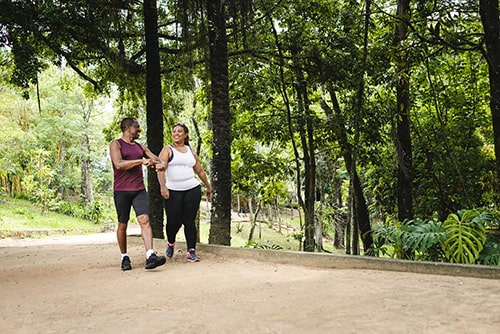With the new year upon us and everyone full steam ahead on their New Year’s resolutions, you might find your usual gym, fitness facility, or group class overwhelmingly packed and untenable.
If your usual exercise spots are overcrowded (or going to the gym just isn’t your thing in the first place), what can you do to ensure you still get in a good workout? Try expanding your walking routine to include some walking workouts and see how fast you can ramp up your exercise results.
BREAKING: Shed 42 lbs In 30 Days With This Simple Night-time Pill
Health Benefits of Walking
Walking may seem like quite an easy and benign form of exercise, but it turns out it packs more of a punch than you might think. This basic form of exercise can appeal to people of all fitness levels and ages and can even be combined with other exercises to produce an incredibly effective and all-encompassing workout routine.
Is your interest piqued? Well, it should be. It’s a well-known fact that unhealthy behaviors and a lack of movement (sedentary lifestyle) are massive contributing factors to a decline in health and an uptick in chronic illnesses. Walking workouts may quickly become your new favorite mode of exercise and your saving grace. Here are a few reasons why:
- You can walk virtually anywhere
- It’s natural—it’s a natural way to exercise without any gimmicks
- It’s free—there is typically no charge for walking in parks, on trails, or virtually anywhere you’d like to go. And if you live in a colder climate, many malls and large retailers even encourage walkers to use their facilities during the winter.
- It can be done anywhere—you have pretty much unrestricted access
- No skills are needed—walking requires no skill; you already know how to do it
- No equipment is necessary—walking is truly the quintessential “bodyweight” workout; you always have all the “equipment” you need
- There’s very low danger of overtraining—you’d be hard-pressed to walk “too much”
- It’s easy to improve cardiovascular conditioning—walking effortlessly improves conditioning
- It strengthens your legs—with regular walking, strength is improved
- It strengthens and tightens your core—with regular walking, your core will engage and become stronger and more trim
- It improves the ratio of body fat to muscle mass—you lose fat naturally over time
- It increases flexibility—using the muscles needed to walk, you’ll naturally increase your level of flexibility and range of motion
- It increases stability (there’s less danger of falling)—the more you walk, the more stability you’ll experience
- It reduces blood pressure—walking improves health markers across the board
- It lowers cholesterol levels—and helps improve overall health
- It prevents diabetes, obesity, hypertension—to improve your health and strengthen your immune system
- It reduces the onset of osteoporosis—by strengthening your bones from the gentle repeated impact
- It increases HDL cholesterol levels
- It reduces anxiety and depression—and is a great way to clear your mind to better think through solutions, goals, and any issues you may be dealing with
- It helps you stick to healthier habits—walking can even help strengthen your resolve!
Ramp Up Your Walking Workouts
If you’re game, you can boost the effectiveness of your basic walk with a few simple tweaks and additions.
Try these Walking Workouts
Begin your walking workout by warming up with a 10-minute stroll at a comfortable pace. After you are thoroughly warmed up, stop and do:
Workout 1: Good morning stretches—begin with your feet hip-width apart. Place your hands lightly behind your head. Keep your gaze fixed forward as you bend at the waist, kicking your hips back. Move your torso down until it is parallel to the ground. Pause, feeling the stretch through your back and hamstrings. Straighten again to complete one repetition. Repeat five times.
Continue your walk for 5 to 10 minutes, but pick up the pace, so you’re slightly out of breath but can still carry on a conversation. After 5 to 10 minutes, stop and perform the following:
Workout 2: Walking lunges—start with your feet hip-width apart. Place your hands on your hips and take a giant step forward with your right foot. Bend your knees, allowing your hips to move forward and down, keeping your left foot behind you. Maintain an upright torso and look straight ahead as you bend down. Pause when your knees form a 45-degree angle, and then push through your front heel to return to the starting position. Repeat on the opposite side. Do five walking lunges on each side.
Do another brisk 5- to 10-minute walk. Next, do this exercise:
Workout 3: Tree Pushups—start by standing about a foot or two away from a tree, facing it. Next, lean forward and place your hands on the tree in front of you with your palms facing forward and your arms straight. Keep your body straight while bending your arms at the elbows. Bring your face as close to the tree as you can (without touching your face to it). Straighten your arms again as you push your body back up to an upright position. To make the exercise more challenging, step your feet further back, so your body is at more of a diagonal than straight up and down.
Resume your brisk walk for 5 to 10 minutes. When ready, perform:
Workout 4: Planks—get into an upper pushup position on the ground. You can stay up in the upper position of the pushup, or if you have a nice, soft grassy area, you can lower your upper body onto your forearms with your elbows aligned below your shoulders. Whichever variation you choose, make sure your back stays in a straight line from your head to your heels (you’ll be up on your toes). Hold this position for 20 – 30 seconds. Release by dropping to your knees. Rest and repeat three times.
Begin the final stretch of your walk, another 5 to 10 minutes of moderately fast (brisk) walking. When you reach the 5- to 10-minute mark, do these:
Workout 5: Bodyweight squats—begin by placing your hands lightly on each side of your head. With your feet about hip-width apart or slightly wider, bend at the knees while simultaneously kicking your hips back until your thighs are right about parallel with the floor. Push back up to the standing position using your leg and glute muscles.
Variations on This Walking Workout
You may be lucky enough to live near a location that boasts a fitness trail (aka calisthenics park), meaning a walking path with fitness equipment along the way. You’ll often see these trails with “stations” at certain intervals that allow you to stop and use monkey bars, pull-up and pushup bars, jump stumps or platforms, balance beams, climbing ropes, and more.
TRENDING: This Keeps Your Blood Sugar Below 100 - Even When You're Eating Sweets!
If you don’t have such a trail nearby, you can always ramp up your own workouts with some exercise bands and a jump rope. Try using your exercise band to add biceps curls, lateral shoulder raises, side lunges, triceps extensions, kickbacks, and more to your walking workouts.
Whether you’re avoiding a crowded gym, just want some time outdoors, or are beginning your fitness journey, walking workouts can not only help you get in better shape, they also offer numerous health benefits. And by adding just a few additions, you can turn it into a full-body, fun, effective workout. Enjoy!









